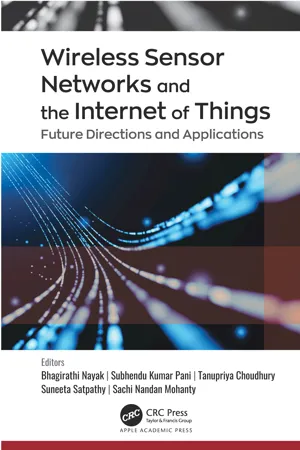
Wireless Sensor Networks and the Internet of Things
Future Directions and Applications
Bhagirathi Nayak, Subhendu Kumar Pani, Tanupriya Choudhury, Suneeta Satpathy, Sachi Nandan Mohanty, Bhagirathi Nayak, Subhendu Kumar Pani, Tanupriya Choudhury, Suneeta Satpathy, Sachi Nandan Mohanty
- 362 pages
- English
- ePUB (mobile friendly)
- Available on iOS & Android
Wireless Sensor Networks and the Internet of Things
Future Directions and Applications
Bhagirathi Nayak, Subhendu Kumar Pani, Tanupriya Choudhury, Suneeta Satpathy, Sachi Nandan Mohanty, Bhagirathi Nayak, Subhendu Kumar Pani, Tanupriya Choudhury, Suneeta Satpathy, Sachi Nandan Mohanty
About This Book
Wireless Sensor Networks and the Internet of Things: Future Directions and Applications explores a wide range of important and real-time issues and applications in this ever-advancing field. Different types of WSN and IoT technologies are discussed in order to provide a strong framework of reference, and the volume places an emphasis on solutions to the challenges of protection, conservation, evaluation, and implementation of WSN and IoT that lead to low-cost products, energy savings, low carbon usage, higher quality, and global competitiveness.
The volume is divided into four sections that cover:
- Wireless sensor networks and their relevant applications
- Smart monitoring and control systems with the Internet of Things
- Attacks, threats, vulnerabilities, and defensive measures for smart systems
- Research challenges and opportunities
This collection of chapters on an important and diverse range of issues presents case studies and applications of cutting-edge technologies of WSN and IoT that will be valuable for academic communities in computer science, information technology, and electronics, including cyber security, monitoring, and data collection. The informative material presented here can be applied to many sectors, including agriculture, energy and power, resource management, biomedical and health care, business management, and others.
Frequently asked questions
Information
PART I Wireless Sensor Networks and Their Relevant Application
CHAPTER 1 Intelligent 5G Networks: Challenges and Realization Insights
1Department of Computer Science, Baba Farid College, Bathinda, Punjab, India
2Department of Computer Science and Engineering, Baba Farid College of Engineering and Technology, Bathinda, Punjab, India
*Corresponding author. E-mail: [email protected]
1.1 INTRODUCTION
1.2 THE FUTURE GENERATION NETWORKS: 5G NETWORKING
| Technology/Generation | Time | Bandwidth | Technology Used | Network | Multiplexing | Switching | Primary | Variations |
|---|---|---|---|---|---|---|---|---|
| 1G | 1970-0 | 2 kbps | Analog | PSTN | FDMA | Circuit | Analog Devices | Mobility |
| 2G | 1990-2004 | 64 kbps | Digital | PSTN | TDMA/CDMA | Circuit & Packet | Digital Devices & SMS | Security and Acceptance |
| 3G | 2004-2010 | 2 Mbps | CDMA 2000, UMTS, EDGE | Packet NW | CDMA | Packet | Phone Calls, Data and SMS Services | Reliablie and better services |
| 4G | NOW | 1 Gbps | Wi Max, WiFi, LTE | Internet | CDMA | Only Packet | All Services | Faster broadband and low network latency |
| 5G | SOON | Higher than previous | WWWW | Internet | CDMA | All Packets | Advance and High Capacity data broadcast services | Better connectivity, better offloading and reduced latency and many more |
Table of contents
- Cover
- Half Title
- Title Page
- Copyright Page
- Table of Contents
- Contributors
- Abbreviations
- Preface
- PART I: Wireless Sensor Networks and Their Relevant Application
- PART II: Smart Monitoring and Control System with the Internet of Things
- PART III: Attacks, Threats, Vulnerabilities and Defensive Measures for Smart Systems and Research Challenges
- Index